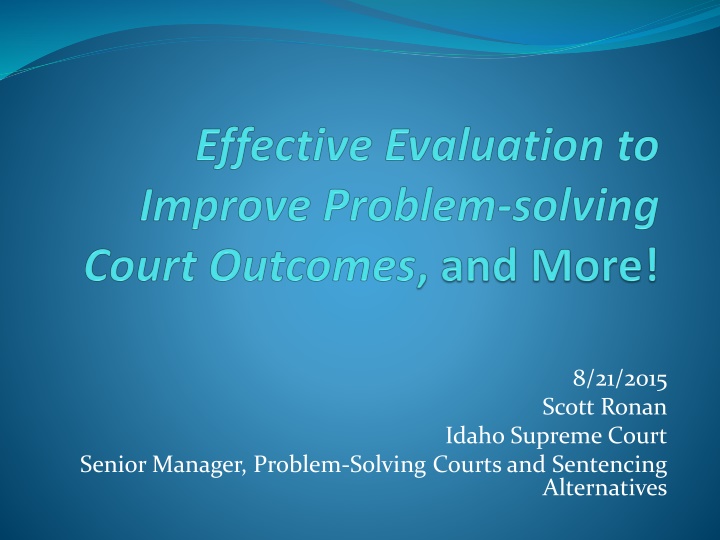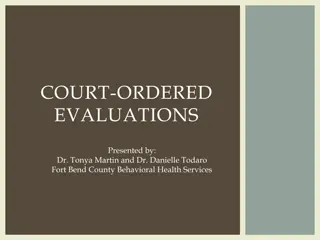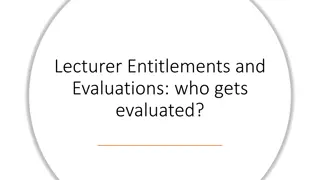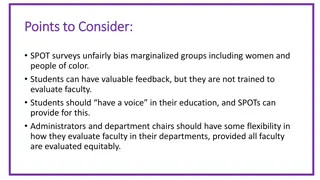
Utilizing Data and Evaluations for Enhanced Program Outcomes in Problem-Solving Courts
Explore how collecting data and utilizing evaluations can lead to improved outcomes in problem-solving courts. Learn about the impact of program evaluations, modifications based on findings, and the importance of monitoring and evaluating data for effective decision-making and program improvements.
Download Presentation

Please find below an Image/Link to download the presentation.
The content on the website is provided AS IS for your information and personal use only. It may not be sold, licensed, or shared on other websites without obtaining consent from the author. If you encounter any issues during the download, it is possible that the publisher has removed the file from their server.
You are allowed to download the files provided on this website for personal or commercial use, subject to the condition that they are used lawfully. All files are the property of their respective owners.
The content on the website is provided AS IS for your information and personal use only. It may not be sold, licensed, or shared on other websites without obtaining consent from the author.
E N D
Presentation Transcript
8/21/2015 Scott Ronan Idaho Supreme Court Senior Manager, Problem-Solving Courts and Sentencing Alternatives
Collecting data and using evaluations to make programmatic changes results in better outcomes! Who says so? NPC Research, NADCP, & Idaho Standards What Data and What Evaluations? Utilization Report data, ISTARS/dashboard data, peer review recommendations, & Idaho Outcome Evaluations How can you use this data to make changes?
Who?NPC Research Drug Court Best Practices (Practices Related to Significant Reductions in Recidivism and Higher Cost Savings) -69 drug courts were included in an analysis that examined the drug court ten key components compared to outcomes Key Component # 8-Monitoring and evaluation measure the achievement of program goals and gauge effectiveness FINDINGS! 8.1 The results of program evaluations have led to modifications in drug court operations
Cont 8.2 Review of program data and/or regular reporting of program statistics has led to modifications in drug court operations 8.3 The drug court maintains data that are critical to monitoring and evaluation in an electronic database (rather than paper files). 2008. Exploring the Key Components of Drug Courts: A Comparative Study of 18 Adult Drug Courts on Practices, Outcomes and Costs. Drug Court Peer Review-Vol VIII, Issue 1, Special Issue. What Works The Ten Key Components of Drug Court: Research Best Practices. Pgs. 60-66. http://npcresearch.com/wp-content/uploads/NIJ_Cross-site_Final_Report_03082.pdf
NPC Research Top Ten Practices for Reducing Recidivism Drug Courts where internal review of the data and program statistics led to modifications in program operations had 105%greater reductions in recidivism. The key elements to this best practice are twofold: 1) The program uses an electronic data collection and management system that allows staff to provide the Drug Court with relevant statistics on program performance and operations, which the team can use to garner insights into its performance, guide improvements, and reveal areas where training is needed. 2) The Drug Court uses the data as a basis for practical program change and continues to use it to monitor progress
Top Ten Practices for Cost Savings Many of the top ten practices for reducing recidivism are the same ones that also contribute to saving costs. These findings are both in the top ten for reducing recidivism and costs! 1. Drug Courts where internal review of the data and program statistics led to modifications in program operations had 131%higher cost savings Regularly monitoring data further provides feedback that the team can use to make necessary adjustments to meet goals in a timely and regular manner. 2. Drug Courts that had evaluations conducted by independent evaluators and used them to make modifications in Drug Court operations had 100%greater cost savings this practice depends on the program s willingness to make changes based on data and to continue to use data to monitor progress. 2012. Drug Court Peer Review-Vol VIII, Issue 1, Special Issue. What Works The Ten Key Components of Drug Court: Research Best Practices. Pgs. 25-31 http://www.ndci.org/sites/default/files/nadcp/DCR_best-practices-in-drug-courts.pdf
Who? NADCP Standards Vol II X. Monitoring and Evaluation- pg.59 A. Adherence to Best Practices B. In-Program Outcomes C. Criminal Recidivism D. Independent Evaluations E. Historically Disadvantaged Groups F. Electronic Database G. Timely and Reliable Data Entry H. Intent-to-Treat I. Comparison Groups J. Time at Risk http://www.ndcrc.org/sites/default/files/adult_drug_court_best_practice_standa rds_volume_ii.pdf
Who? Idaho Standards & Guidelines for Effectiveness And Evaluation- Pgs. 14-15 *Only Standards are represented here. For the full list, follow the link below 5.0 EVALUATION 5.1 Specific and measurable criteria marking progress should be established and recorded in ISTARS for each drug court participant (i.e. drug testing results, compliance with program requirements, sanctions and incentives, participation in treatment, payment of fees, etc.). 5.3 Drug Courts shall utilize the ISTARS Drug Court Module to record participant information and information on participation, phase movement and graduation. 5.5 Drug courts shall provide utilization data to the Idaho Supreme Court promptly by the 10th of the month. The utilization report provides at a minimum, the number of participants active in drug court at the Revised December 12, 2011 15 start of the month, the number of new admissions to drug court during the month, the number of unsuccessful terminations and graduates during the month, and the number of participants enrolled on the last day of the month.
5.8 Initial drug court intake information must be obtained for each participant assessed for entry into drug court. Complete intake information must be obtained for all participants who enter drug court. This data must be entered into the ISTARS drug court module. This information is essential to evaluate the effectiveness of the Idaho Drug Courts. 5.10 A client feedback evaluation should be conducted twice-per-year by each drug court. 5.11 An annual report, The Effectiveness of Idaho Drug Courts will be presented to the Governor and the Legislature by the Idaho Drug Court Coordinating Committee, no later than the first day of the Legislative session. 5.12 Evaluation results/ recommendations should be reviewed and implemented on at least an annual basis and be used to analyze operations, modify program procedures, gauge effectiveness, change therapeutic interventions, measure and refine program goals, and make decisions about continuing or expanding the program. http://www.isc.idaho.gov/psc/DCMHCC_Guidelines_and_Standards_Rev12-2011.pdf
What Data? ISTARS data-dashboard data Peer review recommendations Idaho Outcome Evaluations
ISTARS Data Dashboard Report Sample:
Peer Review Findings-strengths Typical types of findings resulting from a peer review: Strengths- [1.7] Fees are required [2.3] Candidates undergo a criminogenic risk assessment [3.7] Treatment services offered include: a cognitive, behavioral model and addresses criminal thinking Participants spend a minimum of 3 minutes with the Judge per court appearance on average [4.21] Program protects against unauthorized sharing of sensitive participant information In order to graduate, participants must have a sober housing environment.
Peer Review-Areas for improvement- Practices Based on Idaho Standards and Guidelines: [1.8] Participant pays for treatment, but on a sliding scale [5.10] Client feedback obtained twice per year using statewide format; data used by team to consider changes in court operations. [5.12] Program evaluation results/recommendations reviewed and implemented, used to make program modifications [6.4] Trial Court Administrator in each District convenes an annual meeting to discuss district-wide issues affecting program operations and outcomes. [6.6]Judge convenes team meeting at least 2 times per year for training for entire team (Coordinator assesses training needs and arranges training) Practices Based on NPC Research Findings: Estimate time between arrest and referral is 50 days or less Program offers health care and/or dental care Team members are given a copy of the guidelines for sanctions New hires to the drug court complete formal training/orientation
FDC outcome Evaluation Key Findings: Greater use of jail as a sanction = higher risk of recidivism. Higher levels of family engagement = lower risk of recidivism. Offenders in courts that reduce hearings in later phases have a 30% lower risk of recidivating One additional hour individual treatment 2% decrease in risk of recidivism. One additional hour recovery support services 3% decrease in risk of recidivism. A decrease in treatment in later phases increases the likelihood of graduation.
How can you use this data to make changes? Review available information Meetings not Staffings Discuss practices/outcomes with team Set Goals Periodic check-ins for follow-up Ask! advice, assistance, analysis, etc. Achieve Goals!
Remember! Better outcomes = making changes based on data






















